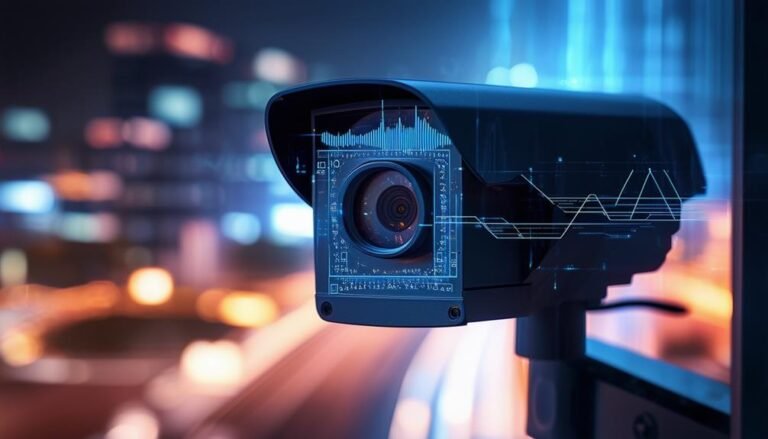Unbinding your Dahua NVR is simple. First, verify you're connected to the same network as the NVR. Access the NVR's web interface by entering its IP address in a browser and log in with admin credentials. Navigate to the "Settings" menu and find "Device Management." Select the device you want to unbind and click "Unbind," confirming your choice. Finally, restart the NVR to make the changes effective. Make sure to back up any important data before unbinding for a smoother process. If you're looking for more tips to optimize your setup, there's still more to uncover.
Understanding NVR Binding
Have you ever wondered what NVR binding really means? NVR binding is a process that connects your Network Video Recorder (NVR) to a specific set of cameras. It's like creating a secure relationship between your surveillance system and the devices you choose to monitor your environment. By binding your NVR to particular cameras, you're ensuring that only those cameras can communicate with your NVR, enhancing security and preventing unauthorized access.
When you bind your NVR, you're fundamentally locking in the devices that you want to use. This is vital for maintaining the integrity of your video surveillance system. You want to have complete control over what's connected, right? NVR binding helps eliminate the possibility of rogue devices sneaking in and compromising your security. It gives you the freedom to tailor your surveillance setup according to your unique needs.
However, it's essential to recognize that while binding provides security, it can also create limitations. If you ever want to change or upgrade your cameras, you'll need to unbind the existing ones first. This can feel restrictive, especially when you value flexibility and adaptability in your security measures. Understanding NVR binding is the first step towards gaining that freedom. Knowledge is power, and knowing how your system operates allows you to make informed decisions that align with your desire for security and autonomy. So, explore the world of NVR binding and take control of your surveillance experience!
Preparing for Unbinding
Before you start unbinding your Dahua NVR, you'll need to gather some essential equipment. Make certain you can access the NVR settings and have a backup of any important data stored on the device. This preparation will help guarantee a smooth unbinding process.
Gather Necessary Equipment
Preparing for the unbinding process requires gathering specific equipment to guarantee everything goes smoothly. First, you'll need a reliable computer or laptop with internet access. This will be your primary tool for managing the NVR settings and ensuring you have the freedom to make necessary changes.
Next, have a USB flash drive on hand. You might need it for transferring files or configurations during the process. It's also wise to keep a backup of your existing settings, just in case you want to revert to them later.
Additionally, make sure you have the latest version of the Dahua software installed. This software is essential for accessing and manipulating the NVR's configurations effectively.
Don't forget to keep the NVR's user manual nearby. It'll serve as a handy reference to troubleshoot any unexpected issues that might arise.
Access NVR Settings
To access the NVR settings for unbinding, you'll start by connecting your computer to the same network as the NVR. This connection is vital, as it'll allow you to communicate with the device and make necessary changes. Once connected, open your web browser and enter the NVR's IP address in the address bar. If you're unsure of the IP address, you can often find it in the network settings of the NVR or by using a network scanner.
After entering the IP address, you'll be prompted to log in. Use your admin credentials; if you haven't changed them, the default username and password can usually be found in the device manual.
Here's a quick reference table to help you navigate the settings:
| Action | Description | Tips |
|---|---|---|
| Connect to Network | Verify both devices are connected | Check your router settings |
| Open Web Browser | Use any browser | Chrome or Firefox works best |
| Enter IP Address | Type in NVR's IP | Verify it's correct |
| Log In | Input your credentials | Default might be 'admin' |
| Access Settings | Navigate to the settings menu | Look for unbinding options |
Once you're in, you can prepare for the next steps towards unbinding your NVR.
Backup Important Data
It's essential that you back up any important data before unbinding your Dahua NVR. You don't want to risk losing valuable footage or settings that might take ages to recreate. Start by reviewing what data you've stored—this includes recorded videos, snapshots, and any custom configurations.
Next, connect a USB drive or an external hard drive to your NVR. Most Dahua devices have an option to export data directly to external storage. Navigate through the settings to find the backup option, and select the files you need. Make certain to double-check that your external device has enough space to accommodate everything you're transferring.
If you've got footage you need to keep for legal or security reasons, prioritize that. Once you've backed up your data, take a moment to verify the integrity of the files. Open a few randomly to confirm they transferred correctly.
Accessing the NVR Interface
Accessing the NVR interface can feel intimidating at first, but with a few simple steps, you'll find it manageable. First, make sure your NVR is powered on and connected to your network. You'll need either a monitor connected directly to the NVR or a computer that's on the same network. If you're using a computer, you can access the NVR using its IP address through a web browser.
To find the IP address, you can use the Dahua tool called "ConfigTool," which scans your network for Dahua devices. Once you've located your NVR's IP address, type it into your web browser's address bar. This should redirect you to the login page of the NVR interface.
Now, you'll need your username and password to log in. If you've never changed these, the default credentials are usually "admin" for the username and "admin" or "123456" for the password. However, it's wise to change these for security reasons as soon as you gain access. After entering your credentials, hit "Login."
Upon successful login, you'll be greeted by the main interface, where the real fun begins! Here, you'll have control over your camera settings, recording schedules, and much more. Don't hesitate to explore the various options available; this is your system, and understanding it gives you the freedom to manage your security effectively.
Unbinding Steps
Unbinding your Dahua NVR from its current configuration is a straightforward process that can enhance your system's security and functionality. First, you'll want to access the NVR's main interface, which you've already done. Once you're in, navigate to the "Settings" menu. Here, you'll find an option labeled "Device Management" or something similar. Select this option to proceed.
Next, look for a section that lists all connected devices. You should see the devices currently bound to your NVR. Identify the device you wish to unbind. Once you've located it, select it, and you should see an "Unbind" option or button. Click on this, and the system will prompt you to confirm your action. Just follow through with the confirmation, and the NVR will start the unbinding process.
After the unbinding is complete, it's a good idea to reboot your NVR to guarantee that all changes take effect smoothly. This step might seem trivial, but it helps in revitalizing the system and eliminating any lingering connections.
Troubleshooting Common Issues
When you encounter issues during the unbinding process of your Dahua NVR, it's essential to identify the root cause quickly. One common issue is connectivity problems. Confirm your network connection is stable and that the NVR is properly connected to your router. If you're using Wi-Fi, try switching to a wired connection to eliminate any potential interference.
Another frequent issue is incorrect login credentials. Double-check that you're inputting the right username and password. If you've forgotten your login details, resetting the NVR to factory settings might be necessary, but keep in mind this will erase all previous configurations.
Sometimes, software glitches can occur. Restarting your NVR can resolve minor software issues and refresh the system. If that doesn't work, consider checking for firmware updates. An outdated firmware version could hinder your ability to unbind the device properly.
If you still can't resolve the problem, the user manual or online forums can be invaluable resources. Many users have faced similar issues, and their solutions might just be what you need. Don't hesitate to reach out to Dahua's customer support for assistance as well. They can provide tailored advice based on your specific situation.
Finalizing the Process
After troubleshooting any issues that may have arisen, you're ready to finalize the unbinding process of your Dahua NVR. This step is essential for verifying that your device is free and ready for new configurations or a different account. Follow these straightforward steps to wrap things up smoothly.
First, verify you're logged into the NVR with administrative privileges. Navigate to the settings menu where the binding options are located. Here's a simple table to help you keep track of what to do next:
| Step Number | Action | Notes |
|---|---|---|
| 1 | Access the settings menu | Use the admin credentials |
| 2 | Locate 'Device Binding' | This may vary by model |
| 3 | Select 'Unbind' | Confirm the action |
| 4 | Save changes | Always save your settings |
| 5 | Restart the NVR | This verifies changes apply |
Once you've completed these steps, check your NVR's status to confirm that it's indeed unbound. You might want to run a test to verify everything's functioning correctly. If all's well, you've successfully reclaimed control of your device.
Keep in mind that this newfound freedom allows you to reconfigure your NVR for better performance or link it to a different account. Enjoy your flexibility and the autonomy that comes with a fully unbound Dahua NVR!
Frequently Asked Questions
Can I Unbind Multiple NVRS at Once?
Yes, you can unbind multiple NVRs, but the process isn't as straightforward as it may seem. You'll need to manage each device individually through the interface, which can be time-consuming. If you're looking for a more efficient way, consider checking if your software supports batch operations or script automation. Always make sure you're following the right procedures to maintain your system's integrity while gaining the freedom you seek with your devices.
What Happens to Recorded Footage After Unbinding?
When you unbind an NVR, it's like letting go of a kite you've flown for years; the memories are still there, but the connection's severed. Recorded footage usually remains intact on the device, but if you don't back it up, you risk losing it forever. It's crucial to prioritize your freedom to access those cherished moments. Make certain you've saved everything important before making that decision; don't let that footage slip away.
Is Unbinding Reversible if Needed?
Yes, unbinding can be reversible if you follow the right steps. If you decide to rebind the system later, you can restore previous settings and configurations. However, it's crucial to verify you have all necessary credentials and backups before proceeding. This way, you won't lose access to your features or recorded footage. Just remember, taking the right precautions can give you the freedom to make changes without permanent consequences.
Will Unbinding Affect Connected Cameras?
When you're looking to unbind, you might feel like you're walking on eggshells. Unbinding your NVR can indeed affect connected cameras, as they rely on that binding for communication and control. Once you unbind, those cameras may lose connection and functionality. If you're seeking freedom in your setup, be aware that this could lead to extra steps later to re-establish connections. It's wise to reflect on the implications before you make any moves.
How Often Should I Unbind My NVR?
You don't need to unbind your NVR regularly unless you're facing specific issues or making significant changes to your setup. It's generally a good idea to do it when you're troubleshooting or upgrading your system. Keeping your NVR bound to your devices maintains stability, so only unbind when necessary. Listen to your system's needs and act accordingly; you'll find the right balance that keeps everything running smoothly without unnecessary disruptions.



